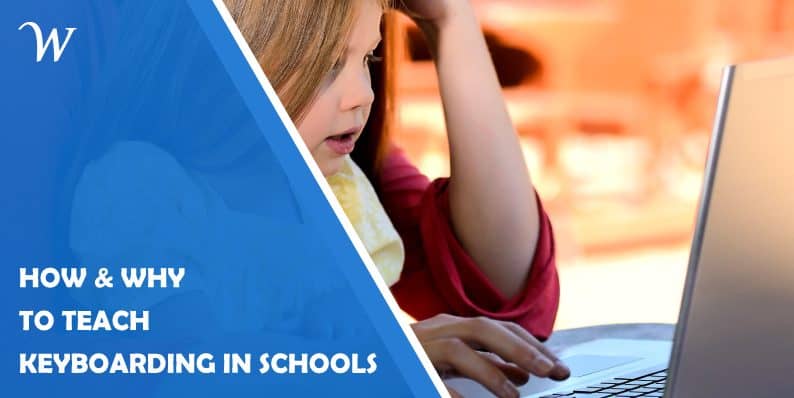How To Teach Keyboarding In Schools, And Why It Is So Important
Keyboarding is a physical and mental skill that is essential in the 21st century. Reasons abound why touch typing is preferable to the hunt-and-peck method of typing, but primarily, the use of muscle memory to practice touch typing makes typing immediate, easy, and accurate.
Consistent use of the keyboard will lead to mastery and unconscious retention of where each letter is on the keyboard. This style of typing leverages the use of muscle memory, which means as you type with your fingers, it also assists with your spelling.
If someone who has been typing for years is asked to describe where a particular letter is on the keyboard, they may not be able to answer quickly because conscious thought is slower than the fingers. If they can set their fingers on a keyboard, they’ll be able to show you right away. Repetitive use of the fingers makes you reach for the individual keys when you need them without conscious thought.
What are the benefits?

Increased productivity results from touch typing since typing becomes faster, so more work can be accomplished. Assignments are more comfortable to perform, and less time is spent in front of the computer. When the process is automatic, it makes cognitive energy flow better.
The ideas flow without being interrupted by language articulation, and there will be a significant improvement in writing quality without constant interruption. The importance of learning to type cannot be overstated since it is the primary method by which students do their homework, and it is how standardized tests are taken.
The growing array of pieces of technology in the classroom, participation in online collaboration, and discussion boards shows the effectiveness of keyboarding. If any student is without the appropriate keyboarding skills, he is at a distinct disadvantage in school during job interviews and computer-based tests.
Indeed, standardized tests are one of the main reasons that keyboarding was added to the U.S Common Core State Standards for English Language Arts. As students advance in school, they are expected to improve in speed and accuracy. Grade 12 students should have developed to the extent that they can type a recommended 50 words per minute at 99% accuracy. Touch typing is one of the best ways to achieve this benchmark.
The U.S common State Standards for keyboarding are:
Grade 3 – Students should be able to produce and publish writing using technology with suitable guidance and support from adults.
Recommended Words per Minute (WPM) and Accuracy: 10WPM at 85% accuracy.
Grade 4 – Students should demonstrate satisfactory command of keyboarding skills and be able to type a minimum of a page in a single sitting.
15 WPM at 90% accuracy.
Grade 5 – Students should demonstrate an adequate command of keyboarding skills to type a minimum of two pages in a single sitting.
15 WPM at 90% accuracy.
Grade 6 – Students should demonstrate the necessary command of keyboarding skills to type a minimum of three pages in a single sitting.
25WPM at 95% accuracy.
Grade 7 – Students should be able to use technology alongside the internet, to produce and publish writing while also linking and citing sources.
30WPM at 95% accuracy
Grade 8 – Students should be able to use technology alongside the internet, to produce and publish writing and present the relationships between ideas and information effectively.
40WPM at 95% accuracy.
Grade 12 – Students should be able to write over a shorter period of time to execute various tasks and speak to various audiences.
Are Tablets as Useful?

In the education sector today, one of the crucial tools being used are tablets. However, it is very important that students learn to type on a computer; the physical keyboard provides an essential physical touchstone for the hands so that students do not need to look at their hands as they write.
This ability to link mind with body, and to write without focusing on the hands, will bring children numerous benefits, both concrete and abstract. On a purely practical note, as children grow older and advance through school, assignments become more prolonged and must be typed.
Touch typing helps students write more fluidly; ideas flow from mind to screen without worrying about the fingers. When mistakes are made, they get corrected quickly, and drafts are easier to edit. Electronic notes taken in class by researchers and students in the University will be of enormous benefit to them. In adult education, touch typing can help develop spelling, increase literacy, and develop computing skills. Group work, standardized sitting exams, and homework/assignments are enabled when students have the appropriate keyboarding skills.
By learning how to type, all students can reach their potential, which helps to solidify their literacy skills. Students with visual impairments, special needs students, and those with learning disabilities also benefit.
To help students turn into capable typists, we have five recommendations:
1. Students should be familiar with a computer keyboard as they learn the alphabet:
Learning touch typing early is essential if students are going to avoid the hunt-and-peck style, which is a slower and less automatic technique.
2. It is easier to learn when you’re having fun:
Games can be the best way to teach keyboarding skills to youngsters. In gamified learning environments, student engagement and motivation levels are increased.
3. The learning experience should be personal:
No two students learn exactly the same way. They acquire keyboarding skills at different levels and speeds. Teachers should personalize keyboarding instructions, and the students will develop at a faster rate.
4. The learning process should be inclusive of all needs:
Over time, flaws in student penmanship and legibility have risen, which is a barrier to learning. Naturally, typing decreases those apprehensions for students. The playing field has been leveled for all students, including those with developmental and physical challenges, because typing creates room for students of all types to succeed.
5. Practice makes perfect:
The key to typing is muscle memory, which is built through repetitive use of the fingers while typing. When patterns are established, we can type with accuracy and very quickly. This process reduces the stress of thinking about where the appropriate keys are. We only worry about what we should be writing and whether it will be worth reading in the end.
Keyboarding is an essential skill nowadays. These suggestions, when integrated into the curriculum, will help your students develop that skill with good technique.
- How To Teach Keyboarding In Schools, And Why It Is So Important - October 8, 2019
Where Should We Send
Your WordPress Deals & Discounts?
Subscribe to Our Newsletter and Get Your First Deal Delivered Instant to Your Email Inbox.



